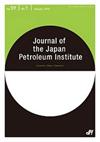Dehydrogenation of Lower Alkanes Using H2S
IF 0.6
4区 工程技术
Q4 ENERGY & FUELS
引用次数: 0
Abstract
Propylene is an important building block for the production of polypropylene, propylene oxide, and acrylonitrile. The main processes for propylene production are steam cracking (SC) of naphtha and fluid catalytic cracking (FCC). The processes of SC and FCC produce ethylene and gasoline as the main products, respectively, and propylene as a by-product1),2). Although the global demand for propylene increases by approximately 4-5 % per year, there is a risk of shortage of propylene supply3). Therefore, to fulfill the global demand for propylene, the operations of the SC and FCC processes are optimized for lesser production of ethylene and gasoline, respectively, and greater production of propylene4)~6). Recently, the dehydrogenation reaction of propane (C3H8 → C3H6+H2) has received significant attention because dehydrogenation can convert the economic feedstock of propane to valuable propylene7). Because the reaction is reversible, prone to volume expansion, and highly endothermic, higher temperatures and lower pressures are preferred for this reaction. The most important aspect of propane dehydrogenation is the energy required for the endothermic reaction8). However, heat input to the reactor is a major technical challenge. A high reaction temperature used for the replenishment of the heat absorbed during the endothermic reaction results in the occurrence of side reactions and formation of coke, and deactivates the catalyst9),10). Current state-of-the-art research focuses on investigating the synergistic effects of gas-phase oxidants and alkanes to overcome the obstacles to industrial dehydrogenation reactions11). It has been established that catalytic oxidative dehydrogenation (ODH) reactions are sensitive to certain oxidizing agents. A number of oxidants such as oxygen, nitrous oxide, and carbon dioxide have been investigated for the propane dehydrogenation reaction12)~16). ODH can proceed at low temperatures because of the exothermic nature of the reaction without thermodynamic constraints. A vanadium-based material was found to be a selective catalyst for ODH with oxygen, because of its favorable redox properties. Carrero et al. reported that (VOx)n (TiOx)m-supported on SBA-15 catalyst showed a propane conversion of 10 % with a 60 % selectivity for the production of propylene; these values are superior to those of all other V-based catalysts reported to date17). High VOx dispersion is required to achieve high propylene selectivity, and the formation of a linked VTi oxide monolayer is crucial to obtain high reaction rates with relatively high propylene selectivity. Boron nitride (BN) was also reported to display high activity and selectivity; the resultant conversion was 14 % with a 79 % selectivity for the propylene18),19). Lots of studies are focused on enhancing propylene selectivity, however it [Review Paper]用H2S脱氢低链烷烃
丙烯是生产聚丙烯、环氧丙烷和丙烯腈的重要原料。丙烯的主要生产工艺是石脑油的蒸汽裂化(SC)和流体催化裂化(FCC)。SC和FCC工艺的主要产物分别为乙烯和汽油,副产物为丙烯1)、2)。尽管全球对丙烯的需求每年增长约4- 5%,但存在丙烯供应短缺的风险。因此,为了满足全球对丙烯的需求,对SC和FCC工艺的操作进行了优化,分别减少乙烯和汽油的产量,增加丙烯的产量。近年来,丙烷的脱氢反应(C3H8→C3H6+H2)备受关注,因为脱氢可以将丙烷的经济原料转化为有价值的丙烯(7)。由于该反应是可逆的,容易发生体积膨胀,并且吸热性强,因此该反应适宜较高的温度和较低的压力。丙烷脱氢最重要的方面是吸热反应所需的能量。然而,反应堆的热输入是一个主要的技术挑战。用于补充吸热反应中吸收的热量的较高反应温度会导致副反应的发生和焦炭的形成,并使催化剂失活。目前最先进的研究集中在研究气相氧化剂和烷烃的协同作用,以克服工业脱氢反应的障碍。催化氧化脱氢(ODH)反应对某些氧化剂敏感。对丙烷脱氢反应中氧、氧化亚氮和二氧化碳等氧化剂的作用进行了研究。ODH可以在低温下进行,因为反应的放热性质没有热力学约束。钒基材料具有良好的氧化还原性能,可作为氧氧化氢的选择性催化剂。Carrero等人报道SBA-15催化剂上负载的(VOx)n (TiOx)m的丙烷转化率为10%,丙烯的选择性为60%;这些值优于迄今为止报道的所有其他v基催化剂(17)。高VOx分散是实现高丙烯选择性的必要条件,而形成连接的VTi氧化物单层对于获得高反应速率和相对高的丙烯选择性至关重要。氮化硼(BN)也显示出较高的活性和选择性;所得转化率为14%,丙烯选择性为79%(18),19)。许多研究都集中在提高丙烯的选择性上,然而它
本文章由计算机程序翻译,如有差异,请以英文原文为准。
求助全文
约1分钟内获得全文
求助全文
来源期刊

Journal of The Japan Petroleum Institute
工程技术-工程:石油
CiteScore
1.70
自引率
10.00%
发文量
29
审稿时长
>12 weeks
期刊介绍:
“Journal of the Japan Petroleum Institute”publishes articles on petroleum exploration, petroleum
refining, petrochemicals and relevant subjects (such as natural gas, coal and so on). Papers published in this journal are
also put out as the electronic journal editions on the web.
Topics may range from fundamentals to applications. The latter may deal with a variety of subjects, such as: case studies in the development of oil fields, design and operational data of industrial processes, performances of commercial products and others
 求助内容:
求助内容: 应助结果提醒方式:
应助结果提醒方式:


